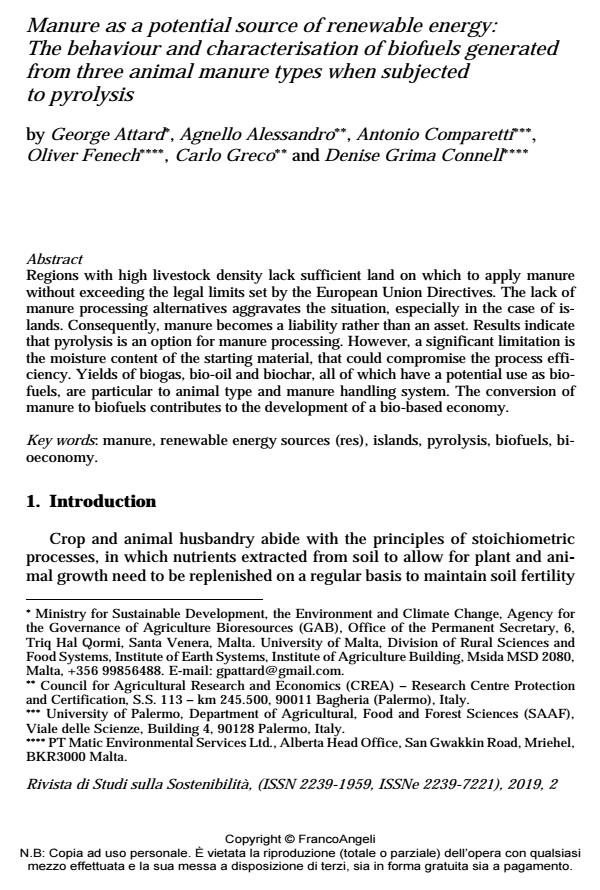Manure as a potential source of renewable energy: The behaviour and characterisation of biofuels generated from three animal manure types when subjected to pyrolysis
Titolo Rivista RIVISTA DI STUDI SULLA SOSTENIBILITA'
Autori/Curatori George Attard, Agnello Alessandro, Antonio Comparetti, Oliver Fenech, Carlo Greco, Denise Grima Connell
Anno di pubblicazione 2020 Fascicolo 2019/2 Suppl. Lingua Inglese
Numero pagine 14 P. 331-344 Dimensione file 130 KB
DOI 10.3280/RISS2019-002-S1021
Il DOI è il codice a barre della proprietà intellettuale: per saperne di più
clicca qui
Qui sotto puoi vedere in anteprima la prima pagina di questo articolo.
Se questo articolo ti interessa, lo puoi acquistare (e scaricare in formato pdf) seguendo le facili indicazioni per acquistare il download credit. Acquista Download Credits per scaricare questo Articolo in formato PDF

FrancoAngeli è membro della Publishers International Linking Association, Inc (PILA)associazione indipendente e non profit per facilitare (attraverso i servizi tecnologici implementati da CrossRef.org) l’accesso degli studiosi ai contenuti digitali nelle pubblicazioni professionali e scientifiche
Regions with high livestock density lack sufficient land on which to apply manure without exceeding the legal limits set by the European Union Directives. The lack of manure processing alternatives aggravates the situation, especially in the case of islands. Consequently, manure becomes a liability rather than an asset. Results indicate that pyrolysis is an option for manure processing. However, a significant limitation is the moisture content of the starting material, that could compromise the process efficiency. Yields of biogas, bio-oil and biochar, all of which have a potential use as biofuels, are particular to animal type and manure handling system. The conversion of manure to biofuels contributes to the development of a bio-based economy.
Keywords:Manure, renewable energy sources (res), islands, pyrolysis, biofuels, bioeconomy.
- Antal Jr. M.J. and Grønli M. (2003). The art, science, and technology of charcoal production. Ind. Eng. Chem. Res., 42: 1619-1640.
- Bourke J., Manley-Harris M., Fushimi C., Dowaki K., Nunoura T. and Antal Jr. M.J.
- (2007). Do all carbonized charcoals have the same chemical structure?. 2. A model of the chemical structure of carbonized charcoal. Ind. Eng. Chem. Res., 46: 5954-5967.
- Dominguez A., Menendez J.A., Inguanzo M. and Pis J.J. (2006). Production of biofuels by high temperature pyrolysis of sewage sludge using conventional and microwave heating. Bioresource Technology, 97(10): 1185-93.
- European Commission (1991). Council Directive 91/676/EEC of 12 December 1991 Concerning the Protection of Waters against Pollution Caused by Nitrates from Agricultural Sources. -- http://eur-lex.europa.eu/LexUriServ/LexUriServ.do?uri=CELEX:31991L0676:EN:HTML.
- European Commission (2000). Directive 2000/60/EC of the European Parliament and of the Council of 23 October 2000 Establishing a Framework for Community Action in the Field of Water Policy. -- http://ec.europa.eu/health//sites/health/files/endocrine_disruptors/docs/wfd_200060ec_directive_en.pdf.
- Goyal H.B., Seal D. and Saxena R.C. (2008). Bio-fuels from thermochemical conversion of renewable resources: A review. Renew. Sustain. Energy Rev., 12: 504-517.
- Jahirul M.I., Rasul M.G., Chowdhury A.A. and Ashwath N. (2012). Biofuels Production through Biomass Pyrolysis - A Technological Review. Energies, 5: 4952-5001.
- Keiluweit M., Nico P.S., Johnson M.G. and Kleber M. (2010). Dynamic molecular structure of plant biomass-derived black carbon (biochar). Environ. Sci. Technol., 44: 1247-1253.
- Oenema O., Oudendag D. and Velthof G.L. (2007). Nutrient losses from manure management in the European Union. Livest. Sci., 112: 261-272.
- Quiroga G., Castrillón L., Fernández Y. and Marañon E. (2010). Physico-chemical analysis and calorific values of poultry manure. Waste management, 30: 880-4.
- Schnitzer M.I., Monreal C.M., Facey G.A. and Fransham P.B. (2007). The conversion of chicken manure to bio oil by fast pyrolysis I. Analyses of chicken manure, bio oils and char by C-13 and H-1 NMR and FTIR spectrophotometry. Journal
- of Environmental Science and Health, Part B, 42(1): 71-7.
- Twidell J. (1998). Biomass energy. Renew. Energy World, 3: 38-39.
- Vamvuka D., Karakas E., Kastanaki E. and Grammelis P. (2003). Pyrolysis characteristics and kinetics of biomass residuals mixtures with lignite. Fuel, 82: 1949-1960.
- Yang W., Ponzio A., Lucas C. and Blasiak W. (2006). Performance analysis of a fixed-bed biomass gasifier using high-temperature air. Fuel proc, technol., 86: 235-245.
George Attard, Agnello Alessandro, Antonio Comparetti, Oliver Fenech, Carlo Greco, Denise Grima Connell, Manure as a potential source of renewable energy: The behaviour and characterisation of biofuels generated from three animal manure types when subjected to pyrolysis in "RIVISTA DI STUDI SULLA SOSTENIBILITA'" 2 Suppl./2019, pp 331-344, DOI: 10.3280/RISS2019-002-S1021